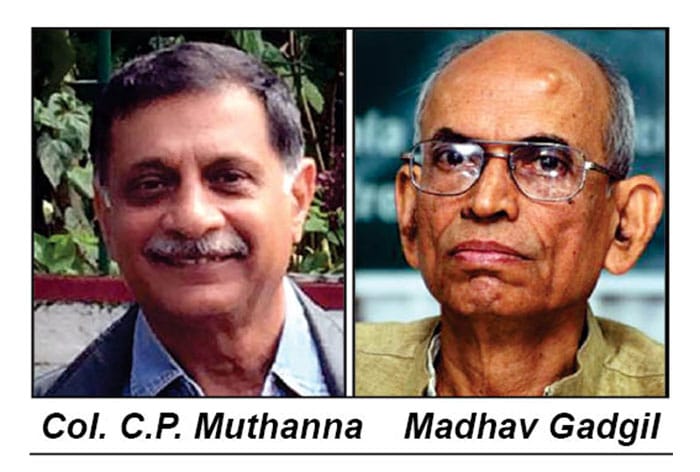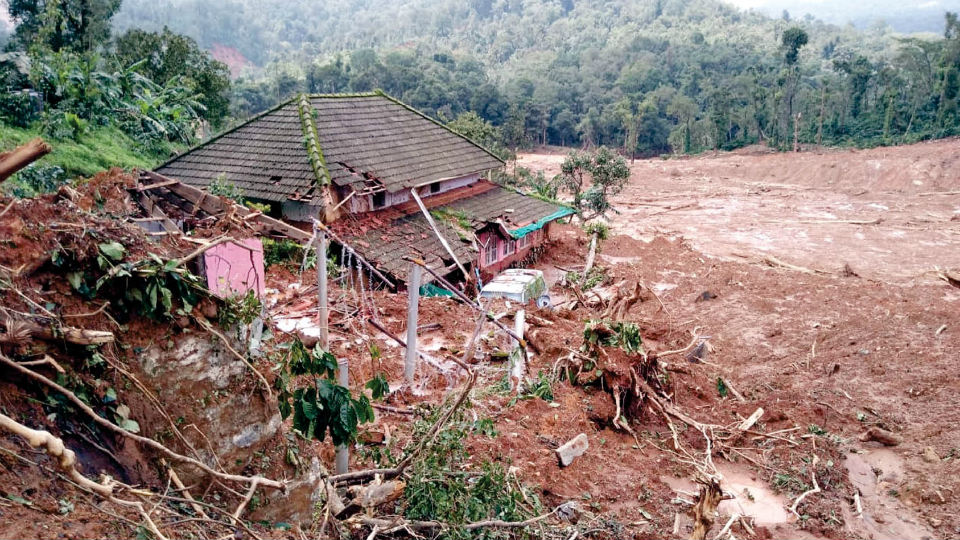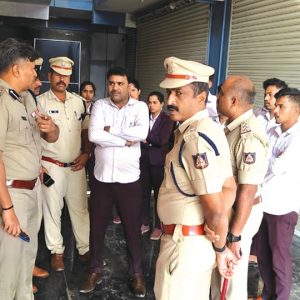By Col. (Retd.) C.P. Muthanna, President, Coorg Wildlife Society
Foreword
According to Col. C.P. Muthanna, President, Coorg Wildlife Society, in the aftermath of the recent devastation of landslides that flattened a few hills in North Kodagu following unprecedented heavy rains, it is wise and imperative to adopt Ecologist Madhav Gadgil Committee Recommendations to stop environmental degradation of whole of Kodagu by declaring the District as Eco-Sensitive Zone (ESZ).
The Kasturirangan Committee Report is a curate’s egg covering 1,576 villages in Karnataka (about 17 villages in Kodagu), recommending them to be declared as ESZ which will not save Kodagu in the long run, rather it will delude us to believe all is okay and we will be protected from this kind of endemic devastation.
Now, there is no time for the State or Central Governments to dither in taking a decision — it must consider accepting Madhav Gadgil Committee Recommendations with some changes.
The suggestion made by Col. Muthanna in this article could be considered as it would save Kodagu for its people to live without fear of natural calamities in the future like what we witnessed in the month of August 2018. – K.B. Ganapathy, Editor-in-Chief
The recent disaster of floods and landslides in Kodagu call for a road map so that we are prepared for the future in a manner that the damage and suffering caused by heavy rainfall are reduced to the extent possible. At the outset, it must be accepted that excess human intervention on the landscape of Kodagu was a major factor. This point can be substantiated by the fact that the areas worst hit by the floods such as Kaloor and Mukkodlu are located close to the Pushpagiri Wildlife Sanctuary.

While these villages witnessed massive landslides with the collapse of entire hills, the steep hills of Pushpagiri forests have remained intact except for a few landslips. And this must be viewed against the fact that these forests that are further to the West, would have received at least 20% more rains than the affected villages. Without going into too much of further analysis, let us look at certain immediate policy decisions and measures that are needed.
1. Urbanisation
We have obtained details through Right To Information (RTI) Act that approximately 2,800 acres of coffee plantations and wet lands in Kodagu were converted for commercial purpose between 2005 – 2015. The recent order of the State Government to put on hold all land conversion is welcome.
While land conversion for private residential purpose, building of labour quarters, etc., must be allowed, the State Government must pass an ordinance for Kodagu and other Malnad districts to ban all land conversion for commercial purpose such as layouts, sites, resorts, gated communities etc. Moreover, there should be strict town and city delimitation with a cap on the number of stories to be restricted to ground floor plus one. The Comprehensive Development Plan [CDP] for Madikeri envisages the expansion of Madikeri by upto three times by 2030. This CDP was pushed through despite several objections by the public. It will now be necessary to shelve the Madikeri CDP permanently. The Maland districts of Karnataka should have building regulations along the lines of the Tamil Nadu Districts Municipalities (Hill Stations) Building Rules 1993. This will help to prevent constructions on steep slopes, which are a recipe for disaster
2. Illegal Sand Mining
Some of the massive landslides that occurred in Kodagu were due to sloping lands near river banks collapsing as a result of rampant sand mining. During periods of heavy water flow in such rivers, the banks are quickly eroded and the land that was supported by the river banks will collapse. There has to be a well thought system to curb the menace of massive illegal sand mining that has become a highly profitable business in Kodagu.
3. Destructive linear projects
There are two Railway lines and four multi-lane National Highways planned through Kodagu. These will result in the felling of upto 3 lakh trees or more across Kodagu and will also cause further gouging into the hill sides by heavy machinery. These projects must be cancelled for the safety of the people of Kodagu. Moreover, there is also a need to create awareness in Kerala. The Railway lines and multi-lane Highways will create similar damage in the adjoining hill areas of Kerala such as Wayanad and those people will also be more vulnerable in future during periods of excessive rainfall.
4. MASS Tourism
In various direct and indirect ways, mass tourism contributes to degradation of the environment and landscape. This has been demonstrated in the Kedarnath disaster, the Kashmir floods and now it has contributed substantially to the recent calamity in Kerala and Kodagu. This is one of the dangers of becoming a ‘Tourism dependent Economy’. We have been adequately warned by nature and the time has come to regulate rather than promote tourism in Kodagu. The Coorg Wildlife Society has taken up a case with the Karnataka State Tourism Department. One of the main recommendations made by the Coorg Wildlife Society is that all the popular tourist spots of Kodagu must have a pass system whereby only a fixed number of passes are issued daily. These passes will need to be obtained online by payment of a reasonable fee. This system is being followed for the Gir forests which are the habitat of the Asiatic Lion and for the Gangothri Glacier. Moreover, by regulating tourism, the traffic density will reduce considerably and this will do away with the need for multi-lane highways through Kodagu
5. Payment for Ecological Services [PES]
The College of Forestry, Ponnampet, has prepared a document on Payment for Ecological Services for Kodagu. This is a concept whereby people of upland communities who protect the water catchments are compensated through an incentive mechanism by downstream beneficiaries that would include Governments and Industries. Such systems are being successfully implemented in other countries. This would be very important to ensure financial security for the people of Kodagu and in particular to the people who have lost their livelihoods as a result of the recent calamity. Although it is not an easy task, these indigenous communities must be motivated and encouraged to retain their lands through financial support mechanisms. If the land and the people are separated due to distress land sales, then the indigenous communities will lose out badly in the long run
6. Dams
There should never be any projects for construction of dams in Kodagu. During 2005, the Coorg Wildlife Society had filed a Public Interest Litigation against the Barapole Dam, and as a result, the dam was not built. If the dam had been constructed, vast areas of South Kodagu could have been inundated during the recent heavy rains. If the dam gates had been opened, there would have been more flood havoc in the neighbouring area of Kerala; Damned if you do and damned if you don’t !
7. Ecological Territorial ARMY
This has been a long-standing demand by some of the retired armed service officers of Kodagu. Ecological Territorial Army (TA) Units comprise mainly of able bodied ex-servicemen and are employed essentially for restoration of degraded forest areas. A unit in Kodagu could also assist in restoring greenery in the devastated areas of North Kodagu. In addition, the Ecological Territorial Army Unit must be provided special equipment and resources such as boats, sniffer dogs, tents, etc., for immediate rescue and relief operations during any such future emergency in Kodagu.
The funding for the Unit will be from the State and Central Governments but both have been reluctant to foot the bill. While approximately Rs. 10,000 crore is readily available for multi-lane National Highways and Railways through Kodagu, the Governments are hesitant to provide a mere Rs. 48 crore for the establishment of an Ecological Territorial Army Unit; the sad truth is that there is huge money to be made in destruction and construction while protection remains unattractive!
Be that as it may, it is up to us to change the narrative.








If the Gadgil Report is more comprehensive and better for the Western Ghat region than the Kasturirangan Report, why the latter is receiving all the attention now? Are we settling for the 2nd best or just taking comfort in the thought that something is better than nothing? Some explanation is needed about the politics behind this decision so that the public can have a better understanding of all related issues.
The catastrophic monsoon floods in Kerala and parts of Karnataka have revived the debate on whether political expediency trumped science. Seven years ago, the Western Ghats Ecology Expert Panel issued recommendations for the preservation of the fragile western peninsular region. Madhav Gadgil, who chaired the Union Environment Ministry’s WGEEP, has said the recent havoc in Kerala is a consequence of short-sighted policymaking, and warned that Goa may also be in the line of nature’s fury. The State governments that are mainly responsible for the Western Ghats — Kerala, Karnataka, Tamil Nadu, Goa and Maharashtra — must go back to the drawing table with the reports of both the Gadgil Committee and the Kasturirangan Committee, which was set up to examine the WGEEP report. The task before them is to initiate correctives to environmental policy decisions. This is not going to be easy, given the need to balance human development pressures with stronger protection of the Western Ghats ecology. The issue of allowing extractive industries such as quarrying and mining to operate is arguably the most contentious. A way out could be to create the regulatory framework that was proposed by the Gadgil panel, in the form of an apex Western Ghats Ecology Authority and the State-level units, under the Environment (Protection) Act, and to adopt the zoning system that it proposed. This can keep incompatible activities out of the Ecologically Sensitive Zones (ESZs).
At issue in the Western Ghats — spread over 1,29,037 sq km according to the WGEEP estimate and 1,64,280 sq km as per the Kasturirangan panel — is the calculation of what constitutes the sensitive core and what activities can be carried out there. The entire system is globally acknowledged as a biodiversity hotspot. But population estimates for the sensitive zones vary greatly, based on interpretations of the ESZs. In Kerala, for instance, one expert assessment says 39 lakh households are in the ESZs outlined by the WGEEP, but the figure drops sharply to four lakh households for a smaller area of zones identified by the Kasturirangan panel. The goal has to be sustainable development for the Ghats as a whole. The role of big hydroelectric dams, built during an era of rising power demand and deficits, must now be considered afresh and proposals for new ones dropped. Other low-impact forms of green energy led by solar power are available. A moratorium on quarrying and mining in the identified sensitive zones, in Kerala and also other States, is necessary to assess their environmental impact. Kerala’s Finance Minister, Thomas Isaac, has acknowledged the need to review decisions affecting the environment, in the wake of the floods. Public consultation on the expert reports that includes people’s representatives will find greater resonance now, and should help chart a sustainable path ahead.
What a sober and balanced assessment! The imperative for long term solutions, but at the same time the need to change the narrative in the short term by providing economic incentives for conservation and for such sustainable solutions. There are examples where this has been successful. Sikkim has transitioned almost completely to organic farming and banned plastic as well. A clip of a talk by Bittu Sahgal (“The purpose of life is not growth, it is equilibrium… We have embarked on inter generational colonization.” ). https://www.facebook.com/wildwatchers/videos/10150328263620650/